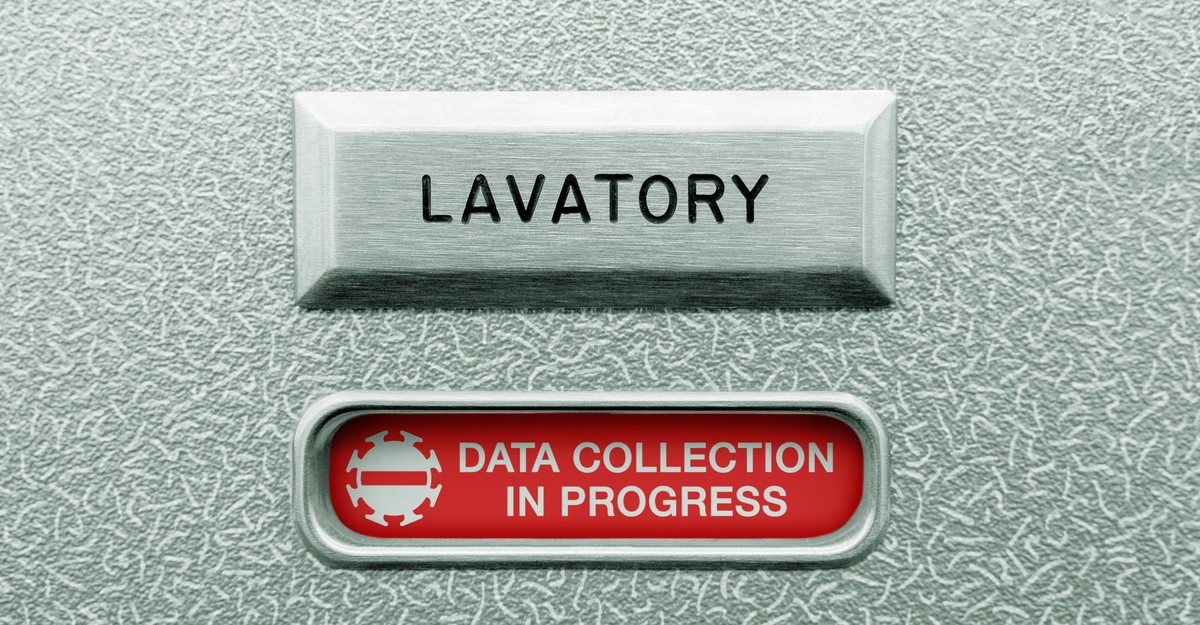Airplane bathrooms are not most people’s idea of a good time. They’re barely big enough to turn around in. Their doors stick, like they’re trying to trap you in place. That’s to say nothing of the smell. But to the CDC, those same bathrooms might be a data gold mine.
This month, the agency has been speaking with Concentric, the public-health and biosecurity arm of the biotech company Ginkgo Bioworks, about screening airplane wastewater for COVID-19 at airports around the country. Although plane-wastewater testing had been in the works already (a pilot program at John F. Kennedy International Airport, in New York City, concluded last summer), concerns about a new variant arising in China after the end of its “zero COVID” policies acted as a “catalyst” for the project, Matt McKnight, Ginkgo’s general manager for biosecurity, told me. According to Ginkgo, even airport administrators are getting excited. “There have been a couple of airports who have actually reached out to the CDC to ask to be part of the program,” Laura Bronner, Ginkgo’s vice president of commercial strategies, told me.
Airplane-wastewater testing is poised to revolutionize how we track the coronavirus’s continued mutations around the world, along with other common viruses such as flu and RSV—and public-health threats that scientists don’t even know about yet. Unlike sewer-wide surveillance, which shows us how diseases are spreading among large communities, airplane surveillance is precisely targeted to catch new variants entering the country from abroad. And unlike with PCR testing, passengers don’t have to individually opt in. (The results remain anonymous either way.) McKnight compares the technique to radar: Instead of responding to an attack after it’s unfolded, America can get advance warning about new threats before they cause problems. As we enter an era in which most people don’t center their lives on avoiding COVID-19, our best contribution to public health might be using a toilet at 30,000 feet.
Fundamentally, wastewater testing on airplanes is a smaller-scale version of the surveillance that has been taking place at municipal water networks since early 2020: Researchers perform genetic testing on sewage samples to determine how much coronavirus is present, and which variants are included. But adapting the methodology to planes will require researchers to get creative. For one thing, airplane wastewater has a higher solid-to-liquid ratio. Municipal sewage draws from bathing, cooking, washing clothes, and other activities, whereas airplane sewage is “mainly coming from the toilet,” says Kata Farkas, a microbiologist at Bangor University. For a recent study tracking COVID-19 at U.K. airports, Farkas and her colleagues had to adjust their analytical methods, tweaking the chemicals and lab techniques used to isolate the coronavirus from plane sewage.
Researchers also need to select flights carefully to make sure the data they gather are worth the effort of collecting them. To put it bluntly, not everyone poops on the plane—and if the total number of sampled passengers is very small, the analysis isn’t likely to return much useful data. “The number of conversations we’ve had about how to inconspicuously know how many people on a flight have gone into a lavatory is hysterical,” says Casandra Philipson, who leads the Concentric bioinformatics program. (Concentric later clarified that they do not have plans to actually monitor passengers’ bathroom use.) Researchers ended up settling on an easier metric: Longer flights tend to have more bathroom use and should therefore be the focus of wastewater testing. (Philipson and her colleagues also work with the CDC to test flights from countries where the government is particularly interested in identifying new variants.)
Beyond those technical challenges, scientists face the daunting task of collaborating with airports and airlines—large companies that aren’t used to participating in public-health surveillance. “It is a tricky environment to work in,” says Jordan Schmidt, the director of product applications at LuminUltra, a Canadian biotech company that tests wastewater at Toronto Pearson Airport. Strict security and complex bureaucracies in air travel can make collecting samples from individual planes difficult, he told me. Instead, LuminUltra samples from airport terminals and from trucks that pull sewage out of multiple planes, so the company doesn’t need to get buy-in from airlines.
Airplane surveillance seeks to track new variants, not individual passengers: Researchers are not contact-tracing exactly which person brought a particular virus strain into the country. For that reason, companies such as Concentric aren’t planning to alert passengers that COVID-19 was found on their flight, much as some of us might appreciate that warning. Testing airplane sewage can identify variants from around the world, but it won’t necessarily tell us about new surges in the city where those planes land.
Airplane-wastewater testing offers several advantages for epidemiologists. In general, testing sewage is “dramatically cheaper” and “dramatically less invasive” than nose-swab testing each individual person in a town or on a plane, says Rob Knight, a medical engineering professor at UC San Diego who leads the university’s wastewater-surveillance program. Earlier this month, a landmark report from the National Academies of Sciences, Engineering, and Medicine (which Knight co-authored) highlighted international airports as ideal places to seek out new coronavirus variants and other pathogens. “You’re going to capture people who are traveling from other parts of the world where they might be bringing new variants,” Knight told me. And catching those new variants early is key to updating our vaccines and treatments to ensure that they continue to work well against COVID-19. Collecting more data from people traveling within the country could be useful too, Knight said, since variants can evolve at home as easily as abroad. (XBB.1.5, the latest variant dominating COVID-19 spread in the U.S., is thought to have originated in the American Northeast.) To this end, he told me, the CDC should consider monitoring large train stations or seaports too.
When wastewater testing first took off during the pandemic, the focus was mostly on municipal facilities, because they could provide data for an entire city or county at once. But scientists have since realized that a more specific view of our waste can be helpful, especially in settings that are crucial for informing public-health actions. For example, at NYC Health + Hospitals, the city’s public health-care system, wastewater data help administrators “see 10 to 14 days in advance if there are any upticks” in coronavirus, flu, or mpox, Leopolda Silvera, Health + Hospitals’ global-health deputy, told me. Administrators use the data in decisions about safety measures and where to send resources, Silvera said: If one hospital’s sewage indicates an upcoming spike in COVID-19 cases, additional staff can be added to its emergency department.
Schools are another obvious target for small-scale wastewater testing. In San Diego, Rebecca Fielding-Miller directed a two-year surveillance program for elementary schools. It specifically focused on underserved communities, including refugees and low-income workers who were hesitant to seek out PCR testing. Regular wastewater testing picked up asymptomatic cases with high accuracy, providing school staff and parents with “up to the minute” information about COVID-19 spread in their buildings, Fielding-Miller told me. This school year, however, funding for the program ran out.
Even neighborhood-level surveillance, while not as granular as sampling at a plane, hospital, or school, can provide more useful data than city-wide testing. In Boston, “we really wanted hyperlocal surveillance” to inform placements of the city’s vaccine clinics, testing sites, and other public-health services, says Kathryn Hall, the deputy commissioner at the city’s public-health agency. She and her colleagues identified 11 manhole covers that provide “good coverage” of specific neighborhoods and could be tested without too much disruption to traffic. When a testing site lights up with high COVID-19 numbers, Hall’s colleagues reach out to community organizations such as health centers and senior-living facilities. “We make sure they have access to boosters, they have access to PPE, they understand what’s going on,” Hall told me. In the nearby city of Revere, a similar program run by the company CIC Health showed an uptick in RSV in neighborhood wastewater before the virus started making headlines. CIC shared the news with day-care centers and helped them respond to the surge with educational information and PPE.
According to wastewater experts, hyperlocal programs can’t usher in a future of disease omnipotence all by themselves. Colleen Naughton, an environmental-engineering professor at UC Merced who runs the COVIDPoops19 dashboard, told me she would like to see communities with no wastewater surveillance get resources to set it up before more funding goes into testing individual buildings or manhole covers. The recent National Academies report presents a future of wastewater surveillance that includes both broad monitoring across the country and testing targeted to places where new health threats might emerge or where certain communities need local information to stay safe.
This future will require sustained federal funding beyond the current COVID-19 emergency, which is set to expire if the Biden administration does not renew it in April. The United States needs “better and more technology, with a funding model that supports its development,” in order for wastewater’s true potential to be realized, Knight said. Airplane toilets may very well be the best first step toward that comprehensive sewage-surveillance future.






